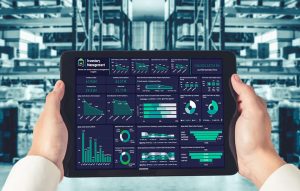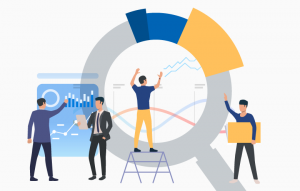Imagine a world where data isn’t locked away in silos, accessible only to a select few. Picture an environment where every employee, regardless of their technical background, has the power to leverage insights for informed decision-making. This is the transformative potential of data democratization.
Data democratization is the strategic dismantling of data barriers. It’s about empowering the entire workforce to access, analyze, and utilize data to fuel innovation, optimize operations, and drive tangible business value.
As we delve into the intricacies of empowering data democracy, this blog aims to shed light on the pivotal role of Tableau business intelligence (BI) in navigating the challenges associated with unleashing the full potential of data within large enterprises.
An organization that implements a BI solution can experience a 127% return on investment (ROI) in just three years.
– An analysis by Forrester consultant Michael Speyer
Let’s understand data democratization in detail
Data democratization stands as a transformative approach, breaking down traditional data silos and making valuable insights accessible to individuals across organizational levels. This strategic process not only fosters a culture of collaboration and inclusivity but also accelerates decision-making by providing comprehensive access to insights. Beyond technological advancements, data democratization instigates a cultural shift where data becomes a shared resource, fueling innovation and informed decision making.
Utilizing advanced technologies, such as business intelligence tools like Tableau, plays a pivotal role in implementing data democratization, ensuring a more intuitive and inclusive interaction with complex datasets. Data democratization is a key driver for organizations seeking to thrive in the digital era, where agility, collaboration, and data-driven decision making are imperative for sustained success.
Let’s navigate the main challenges in data democratization:
Data security and privacy concerns:
Ensuring the democratization of data without compromising security and privacy is a paramount challenge. Striking the delicate balance between accessibility and robust security measures is crucial to safeguard sensitive information.
Continuous monitoring and optimization:
After the initial implementation, continuous monitoring and optimization of data democratization processes are crucial. Regular assessments of performance, user feedback, and evolving business needs are necessary to ensure that the democratization strategy remains aligned with organizational goals and adapts to changing landscapes.
Integration of disparate data sources:
Enterprises often grapple with the integration of data from disparate sources, each with its own unique format and structure. Seamless integration is essential to derive a comprehensive, unified view of the business landscape.
Scalability for large volumes of data:
The scalability of data democratization efforts becomes a significant challenge as organizations generate and accumulate vast amounts of data. Ensuring that the infrastructure can efficiently handle large volumes of data without compromising performance is crucial.
Balancing cost-effectiveness in implementation:
Managing the costs associated with data democratization initiatives poses a significant challenge. Organizations must strike a balance between investing in advanced technologies, training programs, and infrastructure enhancements while ensuring that the implementation remains cost-effective and aligns with overall budget constraints.
Best practices for data democratization leveraging Tableau BI
1. Define clear objectives and KPIs:
Before embarking on the data democratization journey, clearly define the objectives and key performance indicators (KPIs) that align with the overarching business goals. Establishing a roadmap ensures that Tableau BI is configured to deliver insights that directly contribute to strategic initiatives.
2. Establish a centralized data governance framework:
Maintain control and integrity of democratized data by implementing a robust data governance framework. Define roles, responsibilities, and access levels to ensure data accuracy, security, and compliance with industry regulations. Tableau’s governance functionalities can be utilized for efficient management of data access and permissions.
3. Promote user training and adoption:
Invest in comprehensive training programs to empower users at all levels with the skills to navigate and leverage Tableau BI effectively. Fostering a culture of continuous learning ensures that teams can leverage the full potential of Tableau’s capabilities, promoting self-service analytics and reducing dependency on IT support.
4. Create intuitive dashboards for accessibility:
Design dashboards and reports with a focus on simplicity and clarity. Intuitive visuals enhance accessibility, allowing users to grasp insights quickly. Consider the diverse needs of users, tailoring dashboards to provide relevant information to various stakeholders, regardless of their technical proficiency.
5. Ensure data quality and consistency:
Maintain a high standard of data quality by regularly auditing and cleaning datasets. Consistency in data formatting and definitions is essential for accurate insights. Tableau’s data preparation features can be utilized to clean, shape, and integrate data from various sources, ensuring a unified and reliable dataset.
6. Encourage collaboration with shared workbooks:
Leverage Tableau’s collaborative features to foster teamwork and knowledge sharing. Shared workbooks allow multiple users to collaborate on analyses, share insights, and collectively contribute to informed decision-making. This collaborative approach promotes a culture of inclusivity and collective intelligence.
7. Implement data-level security:
Tailor data access permissions to different user roles within an organization. Tableau’s data-level security features enable organizations to control who can access specific data, ensuring sensitive information is only available to authorized personnel.
8. Utilize Tableau Server for scalability:
As data volumes grow, leverage Tableau Server for scalable and secure deployment. This ensures that the democratization of data remains efficient and performs optimally, even as the organization expands. Tableau Server provides centralized management and distribution of dashboards, supporting the increasing demands of a growing enterprise.
9. Monitor and optimize performance:
Regularly monitor the performance of Tableau dashboards and reports. Identify and optimize any bottlenecks to ensure quick and responsive access to data. Proactive performance management contributes to a positive user experience and reinforces the value of data democratization.
10. Iterate and evolve with user feedback:
Gather feedback from users across the organization and iterate on dashboards and data models accordingly. Continuous improvement based on user insights ensures that Tableau BI evolves to meet the changing needs of the business, fostering a dynamic and responsive data democratization strategy.
Overcoming obstacles in data democratization with Tableau BI
1. Data security and privacy concerns:
Leverage Tableau’s advanced security features, including robust encryption protocols and access controls, to ensure data security. Implement a centralized data governance framework, utilizing Tableau’s governance capabilities, to safeguard sensitive information and ensure compliance with privacy regulations.
2. Maintaining data quality and consistency:
Utilize Tableau’s data preparation tools to clean, shape, and harmonize datasets, ensuring a unified and reliable data foundation. Leverage Tableau’s data quality assurance features to regularly audit and maintain the integrity of democratized data, enhancing overall data quality and consistency.
3. Continuous monitoring and optimization:
Implement Tableau’s monitoring tools to track the performance of dashboards and reports in real-time. Regularly assess user feedback and optimize data democratization processes, ensuring that Tableau BI evolves dynamically to meet changing business needs and performance expectations.
4. Integration of disparate data sources:
Harness Tableau’s robust data integration capabilities to seamlessly connect and consolidate disparate data sources. Employ Tableau’s data blending and joining features to create a unified view of data, facilitating a comprehensive analysis that transcends traditional data silos.
5. Scalability for large volumes of data:
Leverage Tableau Server for scalable and secure deployment. This ensures optimal performance even as data volumes grow. Regularly monitor and optimize dashboards using Tableau’s scalability features, allowing organizations to seamlessly accommodate expanding datasets.
6. Balancing cost-effectiveness in implementation:
Conduct a comprehensive cost-benefit analysis to optimize resource allocation. Consider Tableau’s scalability features, allowing businesses to scale infrastructure based on evolving needs. Regularly review usage and adjust licenses to align with budget constraints, ensuring a cost-effective implementation.
Catalyzing digital transformation: Data democratization with Tableau BI
In the expansive realm of big business, where digital transformation is the cornerstone of success, the adoption of business intelligence services emerges as a pivotal catalyst for democratizing data and steering organizations towards a future of innovation and agility. Data democratization using Tableau BI unfolds as a transformative force, ushering in the era of digital evolution for enterprises:
- Breaking down data silos for seamless integration
- Empowering decision-makers with real-time insights
- Fostering a data-driven culture
- Enhancing customer-centric strategies
- Facilitating data-backed innovation
- Driving operational efficiency and cost savings
Unleashing the power of data democratization for digital transformation
In the grand narrative of big business, the adoption of Tableau BI for data democratization serves as a transformative force propelling organizations toward digital maturity. By breaking down data silos, empowering decision-makers, fostering a data-driven culture, enabling self-service analytics, enhancing customer-centric strategies, facilitating innovation, ensuring scalability, and driving operational efficiency, Tableau BI becomes the linchpin for digital transformation success.
As enterprises embrace the power of democratized data, they position themselves at the forefront of the digital revolution, ready to adapt, innovate, and thrive in the evolving business landscape. Understanding data democratization with Tableau BI is not merely an acknowledgment of a trend; it is a strategic imperative for organizations aiming to thrive in a data-driven era. By breaking down barriers, empowering decision-makers, fostering collaboration, and gaining a strategic advantage, businesses can harness the full potential of their data, ensuring a competitive edge in the complex landscape of big business.









